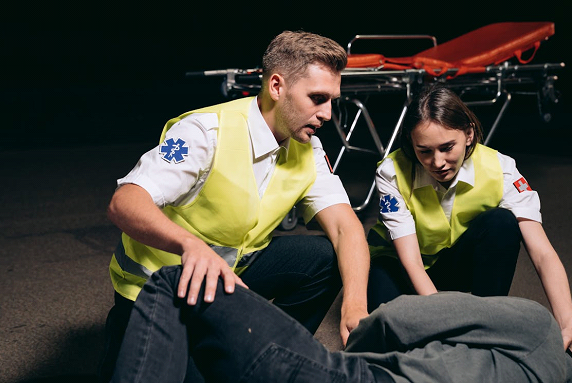Manual handling. It sounds simple, right? But it’s one of the biggest causes of workplace injuries. Poor techniques can lead to severe strain and injury, whether lifting, carrying, or pushing.0
So, how can one stay safe and reduce risks? By understanding and implementing effective manual handling techniques.
Understanding Manual Handling Techniques
Manual handling involves lifting, lowering, carrying, pushing, or pulling an object—anything from a box of files to a piece of machinery. Using proper techniques is crucial to avoid injuries. These techniques are designed to minimise strain on the body, making tasks more accessible and safer.
Why should one bother with manual handling techniques? The answer is simple. Safety. Injuries from manual handling can be severe, leading to long-term problems such as chronic back pain, debilitating muscle strains and persistent joint issues. By using proper techniques, these risks are significantly reduced, safeguarding long-term health.
Additionally, employing the correct methods can make tasks more accessible and more efficient, minimising physical exertion and enhancing productivity. Proper manual handling protects the body and boosts overall job performance, making it a win-win for health and work efficiency.
6 Useful Manual Handling Techniques
So, what are the best manual handling techniques? Here’s a handy list:
The Squat Lift: It is ideal for lifting small, heavy items. Squat down, keeping the back straight and feet shoulder-width apart. Lift with the legs, not the back. This technique ensures that the strong muscles of the legs do the heavy lifting rather than the weaker back muscles. Keeping the back straight helps prevent spinal injuries and distributes the load evenly.
The Power Lift:
It is used for heavy or awkward loads. Start with one knee on the ground and the other foot flat. Lift the load onto the knee, then stand up using the legs. This technique helps lift items that are particularly heavy or difficult to grasp, providing stability and leveraging the strength of the legs. The power lift also helps maintain balance and reduce the risk of falling.
The Tripod Lift:
This is great for objects that are hard to grip. It is similar to the power lift but involves balancing the load on the knee before standing. This lift is particularly useful for uneven or bulky items, allowing better control over the load. Balancing on the knee first helps position the load more securely before fully lifting it.
The Golfer’s Lift
It is perfect for light, small items. Balance on one leg, bending at the hip, and use the other leg for counterbalance. Reach down with one hand to lift the item. This lift mimics the motion of a golfer picking up a ball and is excellent for light items close to the floor. It minimises strain on the back by using the leg as a counterweight, providing stability and precision.
The Partial Squat Lift
It is used for items at waist height. Squat partially, keeping the back straight, and lift with the legs. This lift is ideal for items stored at an intermediate height, reducing the need to bend too far. It combines ease of movement with safe lifting practices, ensuring the back remains supported throughout the lift.
The Overhead Lift
It is for placing items on high shelves. Use a stable platform to reach higher. Keep the load close to the body and avoid overreaching. Always use a stable ladder or step stool for high shelves to avoid stretching or straining the upper body. Keeping the load close reduces the strain on the arms and shoulders, ensuring a safer lift.
How to Implement Manual Handling Techniques
One might wonder how to implement these techniques effectively. Here’s a step-by-step guide to get started:
Training and Awareness: Ensure everyone is trained in proper manual handling techniques and knows the importance of using them. Manual handling training enables workers to recognise their physical limits and when to seek help or use equipment.
Assess the Task: Before lifting or moving anything, take a moment to assess. What’s the weight? How far does it need to go? Are there any obstacles? Planning can prevent accidents. Knowing the exact nature of the task helps you choose the p roper technique and tools. This initial assessment ensures you’re prepared and helps avoid surprises that could lead to injury.
Prepare the Area: Ensure the path is clear. Clear any obstacles that could cause a trip or fall. A clutter-free space is a safe
space. This preparation also includes checking for any hazards that might make the task more difficult or dangerous, such as wet floors or poor lighting. Taking the time to clear the area and address potential hazards creates a safer environment for manual handling.
Use the Right Equipment: Sometimes, it’s better to use tools. Dollies, hand trucks, or forklifts can make a big difference. Use them whenever possible. The right equipment can significantly reduce the physical strain on the body, making handling heavy or awkward loads easier. Utilising appropriate tools protects the body and increases efficiency and effectiveness in moving items.
Lift Properly: When lifting, keep the back straight, bend the knees, and use the legs. Avoid twisting or turning the b
ody while lifting. Twisting can cause severe back injuries, so always turn with the feet, not the torso. Proper lifting techniques are crucial for preventing common injuries and ensuring that the strongest muscles, like those in the legs, bear the load.
Hold the Load Close: Keeping the load close to the body reduces strain. It helps maintain balance and control. The closer the load is to the centre of gravity, the easier it is to manage and the less strain it places on the back. Holding the load close minim ises the leverage effect, which can otherwise amplify strain on the back and arms.
Take Breaks: Don’t overdo it. Regular breaks can help avoid fatigue and reduce the risk of injury. Continuous strain without rest can lead to overuse injuries, so giving muscles time to recover is essential. Scheduled breaks ensure muscles are not overworked, which helps maintain overall health and productivity.
Importance of Manual Handling Training
Training is the key to success in manual handling. It ensures everyone knows how to handle tasks properly, reducing accidents and injuries and creating a safer workplace. Health and safety training is essential for a secure, efficient, compliant workplace.
Proper training teaches the best techniques, boosting employees’ confidence and making tasks easier and quicker, improving efficiency and productivity. It also fosters a safety culture, showing that the company values its employees’ well-being and ensures adherence to health and safety regulations, preventing legal issues and fines.
Proper manual handling techniques are crucial for mitigating strain and injury. Learning and applying these techniques can make a significant impact. Comprehensive training and awareness are essential for all workers. They ensure tasks are performed safely and efficiently, fostering a better work environment. Investing the time to learn and regularly practice these vital techniques is essential.





